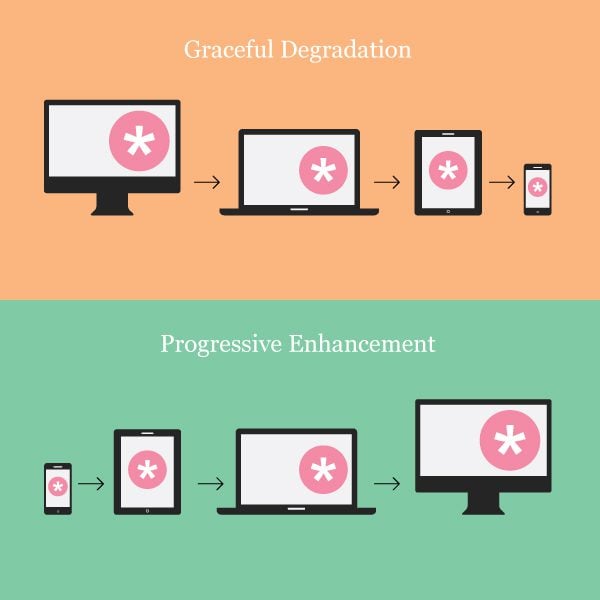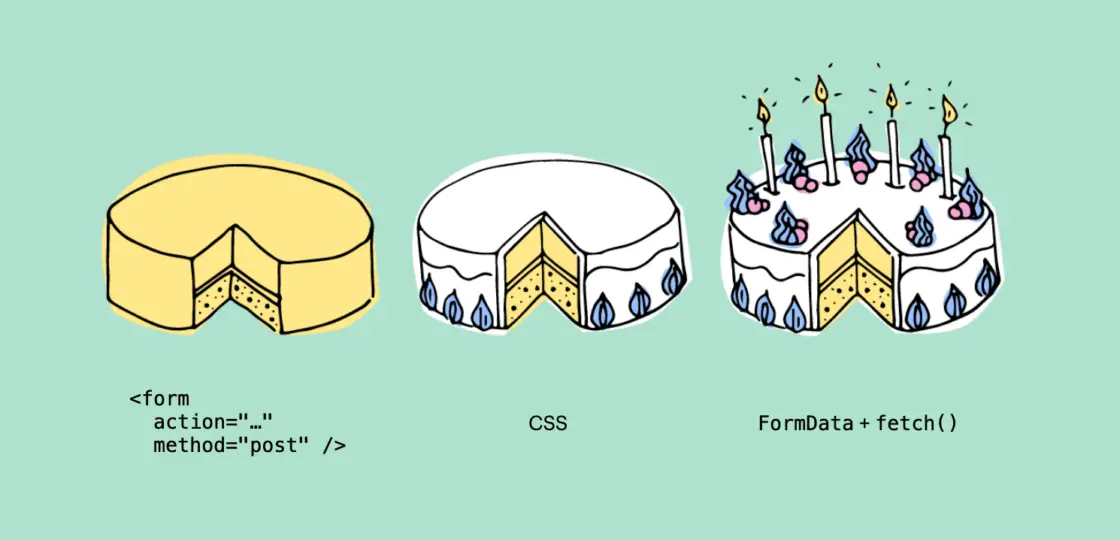Progressive Enhancement: Building for All Web Users

Progressive enhancement is a web development technique that involves:

- Building a basic, accessible website that works for all users. This includes users with disabilities, users with slow internet connections, and users on mobile devices.
- Gradually adding features and functionality, enhancing the user experience for those who have access to them.
Progressive enhancement is based on the idea that all users should have a good experience on your website, regardless of their devices or abilities. By starting with a solid foundation and then adding enhancements, you can ensure that everyone can access and use your content.

Here is a step-by-step guide to progressive enhancement:
- Start with a solid foundation. This means using HTML and CSS to create a basic layout and structure for your website. Make sure your website is responsive, so it can be viewed on all devices.
- Gradually add features and functionality. Once you have a solid foundation, you can start to add features and functionality to your website. This could include things like JavaScript, images, and videos.
- Test your website regularly. Throughout the development process, test your website on different devices and browsers. Make sure that your website is accessible to all users.
Benefits of progressive enhancement
Progressive enhancement has a number of benefits, including:
- Improved accessibility. Progressive enhancement makes your website more accessible to users with disabilities, users with slow internet connections, and users on mobile devices.
- Better performance. A progressively enhanced website will load faster and perform better on all devices.
- Improved user experience. Progressive enhancement creates a better user experience for everyone, by delivering a consistent and accessible website on all devices.
Conclusion
Progressive enhancement is a powerful technique that can help you build accessible, performant, and user-friendly websites. By following the steps outlined above, you can create a website that works for everyone.## Progressive Enhancement: Building For All Web Users
Executive Summary
Progressive enhancement is a web development approach that ensures a site’s functionality is available across all devices and abilities, communicating the critical information to users with limited access. This article discusses five essential subtopics within progressive enhancement; graceful degradation, accessibility, cross-platform usability, backward compatibility, and standardization.
Introduction
Progressive enhancement provides the same consistent, core experience to all, improving accessibility and performance. It enhancing optimization without compromising accessibility by questioning whether a feature works and how it works for users. It’s not just about building websites; it’s about devising online experiences inclusive of everyone.
Graceful Degradation
Graceful degradation, as opposed to progressive enhancement, puts initial focus toward “nice-to-haves” features and reverts to core functionality when limits arise. This approach jeopardizes the user experience for those with limited abilities or slow internet connections.
Core Principles:
- Prioritize Core Functionality: Users should be able to browse, find information, understand site’s content and functionality in the most straightforward manner available to them.
- Minimize Extraneous Features: Features that are nice but not mission-critical should be implemented with the understanding they may need to be omitted for some users.
- Progressive Performance: Consider load speed, responsiveness, and resource consumption to minimize disruptions to the user experience on slower connections or older devices.
Accessibility
Accessibility ensures those with disabilities can successfully interact with the site. Developers must provide alternatives to complex visuals, closed captions for audio recordings, and keyboard navigation for mouse-inability issues.
Core Principles:
- Consider All Users: Understand the diverse set of possible user limitations, including visual, auditory, cognitive, physical, and neurological constraints.
- Clear Content: Communicate information meaningfully and concisely.
- Control Options: Provide site control mechanisms that allow keyboard-only navigation, assistive technologies, and other alternate ways to interact with the page.
Cross-Platform Usability
Cross-platform usability emphasizes the site’s ability to perform across various devices, ensuring an optimized experience. It addresses multiple hardware constraints such as screen size, input methods, and operating system adaptability.
Core Principles:
- Responsive Design: Utilize flexible layouts and flexible content display that automatically adapt to diverse screen sizes.
- Platform Agnostic: Don’t make assumptions about what platform or device a user is coming from; accommodate various browsers and system configurations.
- Accessible on Handheld Devices: Optimize content, functionality, and navigation specifically considering the limitations of mobile browsing.
Backward Compatibility
Backward compatibility emphasizes support for legacy platforms. It preserves the core functionality for older browser versions without sacrificing the benefits of newer technology.
Core Principles:
- Consider Legacy Support: Do not abandon users with older devices or browser version if reasonable to support.
- Feature Rollout: Release enhanced features on a gradual basis, assuring compatibility with multiple versions.
- Common Denominator: Maintain essential functionality and accessibility while judiciously adopting modern techniques that may not be supported by legacy platforms.
Standardization
Standardization incorporates industry standards, such as HTML, JavaScript, and CSS. It ensures that a site remains predictable and navigable across different browsers while maximizing accessibility for assistive technologies.
Core Principles:
- Adherence to Standards: Site infrastructure and content should adhere to the latest and widely adopted web development standards; this reduces irregularities and guarantees consistent outcomes.
- Semantic HTML: Use semantic, meaningful HTML tags for proper content structure; this aids with accessibility and information parsing by search engines.
- Well-Structured CSS: Utilize CSS to control presentation without affecting semantics; it helps with accessibility tools interpret and format content more accurately.
Conclusion
Progressive enhancement empowers everyone to access the web. By incorporating its principles, developers can create future-proof, device-independent experiences. Considering the subtopics presented in this article, it becomes apparent that progressive enhancement is more than just a development strategy; it’s an inclusive approach to the web that leaves no one behind.
Keyword Phrase Tags
- progressive enhancement
- graceful degradation
- accessibility
- cross-platform usability
- backward compatibility

This article provides a clear and concise overview of progressive enhancement. I appreciate the detailed explanation of how to implement progressive enhancement techniques to create websites that are accessible to all users. The examples provided are helpful in understanding the concepts and how to apply them in practice.
I’m not sure I agree with the author’s assertion that progressive enhancement is the best approach to web design. While it’s true that progressive enhancement can improve accessibility, it can also be more complex and time-consuming to implement than other approaches. I think it’s important to weigh the pros and cons of progressive enhancement before deciding whether or not to use it.
Progressive enhancement is a powerful technique that can be used to create websites that are accessible to all users. The key is to start with a solid foundation of HTML and CSS, and then add enhancements progressively, as needed. This approach ensures that your website will be accessible to users of all abilities, regardless of their browser or device.
Progressive enhancement is like a choose-your-own-adventure book for web design. You start with the basic story, and then you add your own enhancements as you go along. The best part is, you can always go back and change your choices later on.
Oh, progressive enhancement. The holy grail of web design. The one true way to make your website accessible to all. But let’s be honest, it’s just a lot of extra work. And for what? So that some old lady can use your website on her ancient browser? I think I’ll pass.
Progressive enhancement is the best way to make your website accessible to all users. But it’s also the best way to make your website more complex and difficult to maintain. So, if you’re looking for a simple and easy way to make your website accessible, progressive enhancement is not for you.
I’m so excited to try progressive enhancement on my next website! I’ve always wanted to create a website that is accessible to all users, and I think progressive enhancement is the perfect way to do it.
I’m a little concerned about the performance implications of progressive enhancement. I’ve heard that it can slow down your website, especially on mobile devices. Is this true?
Progressive enhancement is a great way to improve the accessibility of your website. However, it’s important to remember that it’s not a magic bullet. There are still some things that you can’t do with progressive enhancement, such as creating fully accessible interactive widgets. For those cases, you’ll need to use other techniques, such as ARIA.
I don’t think progressive enhancement is the best approach to web design. I think it’s better to use a mobile-first approach. That way, you can be sure that your website will be accessible to all users, regardless of their device.
Progressive enhancement? More like progressive headache. I’ve tried using it before, and it’s just too much work. I’d rather just use a different approach that’s easier to implement.
Progressive enhancement is like a choose-your-own-adventure book for web design. You start with the basic story, and then you add your own enhancements as you go along. The best part is, you can always go back and change your choices later on.